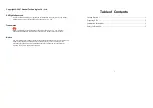
14
D.
I2C Interface:
I2C is used to communicate with peripheral equipment and can be operated as either
a transmitter or receiver, depending on the device function. Use AT Commands
“AT+CRIIC and AT+CWIIC” to read/write register values of related peripheral
equipment connected with I2C interface.
Both SDA and SCL are bidirectional lines, connected to a positive supply via a pull-
up resistor respectively. When the bus is free, both lines are high.
For RC3000A, the data on the I2C bus can be transferred at rates up to 400kbps. The
number of peripheral devices connected to the bus is solely dependent on the bus
capacitance limit of 400pF. Note that PCB traces length and bending are in users’
control to minimize load capacitance.
Note:I2C_SDA and I2C_SCL have been pulled up with two 2.2kR resistors to 2.6V
level in module. So there is no need to pull them up in users’ application circuit.
E.
SPI Interface:
SPI interface of RC3000A is master only. It provides a duplex, synchronous, serial
communication link with peripheral devices. Its operation voltage is 1.8V, with
clock rates up to 26 MHz.
F.
GPIO Interface:
RC3000A provides a limited number of GPIO pins. All GPIOs can be configured as
inputs or ouputs. User can use AT Commands to read or write GPIOs status.
Note-1: If more GPIOs need to be used, users can configure GPIO on other multiple
function interfaces, such as PCM.
Note-2: The output driver current of GPIOs is 2mA.
G.
PCM Interface:
RC3000A provides hardware PCM interface for external codec. The PCM interface
enables communication with an external codec to support hands-free applications.
RC3000A PCM interface can be used in two modes: the default mode is auxiliary
PCM (8 KHz long sync mode at 128 KHz PCM CLK). In short-sync (primary PCM)
mode, RC3000A can be a master or a slave. In long-sync (auxiliary PCM) mode,
RC3000A is always a master. RC3000A also supports 3 kinds of coding formats: 8
bits (
υ
-law or A-law) and 16 bits (linear).
Note: PCM interface is multiplexed from GPIO (default setting). The AT command
“AT+CPCM” is used to switch between PCM and GPIO functions.
ADC Interface:
RC3000A has a dedicated ADC that is available for digitizing analog signals such as
battery voltage and so on; it is on PIN 35 and PIN 36, namely ADC1 and ADC2.















































